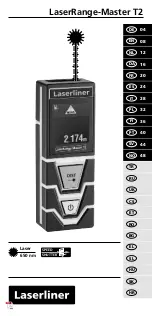
7
Using Labarazzi in stand-alone mode
When turning on the Labarazzi, the built-in display briefly indicates the firmware and
bootloader version.
As the unit per default starts in preset Waveform no. 7, and light source at full load,
the display initially shows:
Interpretation:
Signal:
Waveform (flat = DC/sine/square/triangle/saw/cosine/PWM)
PstLM:
Flicker metric, short term light modulation
–
see more details in
section
SVM:
Stroboscopic visibility measure
–
see more details in section
FI:
Flicker Index
–
see more details in section
Freq:
Frequency
–
all Labarazzi signal are periodic with a defined
frequency
LED:
Indicates whether the built-in LED is currently ON or OFF
BNC:
Indicates whether the built-in external signal is currently ON or
OFF
Bottom red line: Three cycles of the selected signal (in image: flat/no signal
chosen)
Flicker Metrics
Flickering light is a problem at low frequencies and can trigger headaches, fatigue,
and migraine attacks at higher frequencies - even if the effect is not visible. There are
huge differences in how much people are affected by flickering light.
Flicker and stroboscopic effects are only found to a negligible degree in incandescent
bulbs, as the filament does not get cold between each 50 Hz pulse from the power
supply. Many LED solutions, however, are unsatisfactory in this regard - not because
of the LEDs, but because of poor drivers/power supply electronics. Particularly
dimmed LED luminaires and some screw-base LED light sources can be very
flickering.
CIE Technical note CIE TN 012:2021 (“Guidance on the Measurement of Temporal
Light Modulation of Light Sources and Lighting Systems”
) provides a lot of valuable
information on the topic and is free to download.
Viso Labarazzi
Signal: WF7
Intensity: 100%
PstLM 1.88
Freq: 65.00 Hz
SVM 5.05
LED
ON
FI 0.50
BNC Out
OFF































